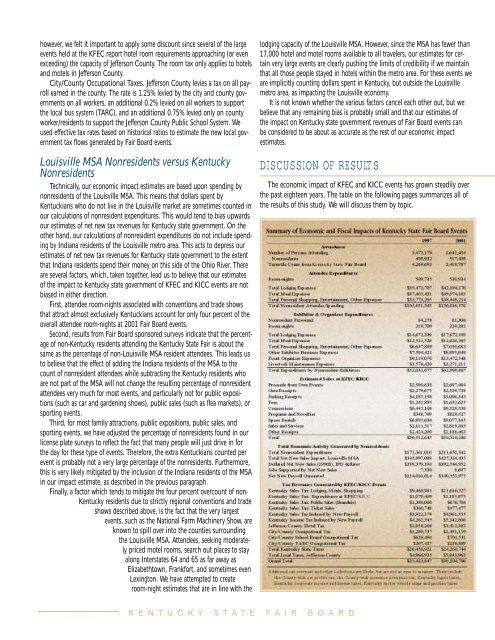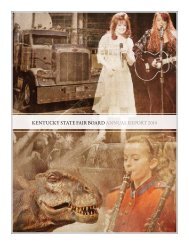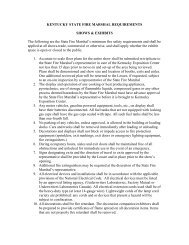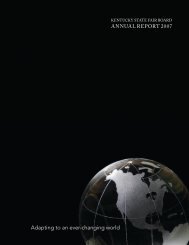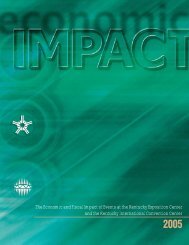2001 Economic Impact Study of the Kentucky State Fair Board
2001 Economic Impact Study of the Kentucky State Fair Board
2001 Economic Impact Study of the Kentucky State Fair Board
Create successful ePaper yourself
Turn your PDF publications into a flip-book with our unique Google optimized e-Paper software.
however, we felt it important to apply some discount since several <strong>of</strong> <strong>the</strong> large<br />
events held at <strong>the</strong> KFEC report hotel room requirements approaching (or even<br />
exceeding) <strong>the</strong> capacity <strong>of</strong> Jefferson County. The room tax only applies to hotels<br />
and motels in Jefferson County.<br />
City/County Occupational Taxes. Jefferson County levies a tax on all payroll<br />
earned in <strong>the</strong> county. The rate is 1.25% levied by <strong>the</strong> city and county governments<br />
on all workers, an additional 0.2% levied on all workers to support<br />
<strong>the</strong> local bus system (TARC), and an additional 0.75% levied only on county<br />
worker/residents to support <strong>the</strong> Jefferson County Public School System. We<br />
used effective tax rates based on historical ratios to estimate <strong>the</strong> new local government<br />
tax flows generated by <strong>Fair</strong> <strong>Board</strong> events.<br />
Louisville MSA Nonresidents versus <strong>Kentucky</strong><br />
Nonresidents<br />
Technically, our economic impact estimates are based upon spending by<br />
nonresidents <strong>of</strong> <strong>the</strong> Louisville MSA. This means that dollars spent by<br />
Kentuckians who do not live in <strong>the</strong> Louisville market are sometimes counted in<br />
our calculations <strong>of</strong> nonresident expenditures. This would tend to bias upwards<br />
our estimates <strong>of</strong> net new tax revenues for <strong>Kentucky</strong> state government. On <strong>the</strong><br />
o<strong>the</strong>r hand, our calculations <strong>of</strong> nonresident expenditures do not include spending<br />
by Indiana residents <strong>of</strong> <strong>the</strong> Louisville metro area. This acts to depress our<br />
estimates <strong>of</strong> net new tax revenues for <strong>Kentucky</strong> state government to <strong>the</strong> extent<br />
that Indiana residents spend <strong>the</strong>ir money on this side <strong>of</strong> <strong>the</strong> Ohio River. There<br />
are several factors, which, taken toge<strong>the</strong>r, lead us to believe that our estimates<br />
<strong>of</strong> <strong>the</strong> impact to <strong>Kentucky</strong> state government <strong>of</strong> KFEC and KICC events are not<br />
biased in ei<strong>the</strong>r direction.<br />
First, attendee room-nights associated with conventions and trade shows<br />
that attract almost exclusively Kentuckians account for only four percent <strong>of</strong> <strong>the</strong><br />
overall attendee room-nights at <strong>2001</strong> <strong>Fair</strong> <strong>Board</strong> events.<br />
Second, results from <strong>Fair</strong> <strong>Board</strong> sponsored surveys indicate that <strong>the</strong> percentage<br />
<strong>of</strong> non-<strong>Kentucky</strong> residents attending <strong>the</strong> <strong>Kentucky</strong> <strong>State</strong> <strong>Fair</strong> is about <strong>the</strong><br />
same as <strong>the</strong> percentage <strong>of</strong> non-Louisville MSA resident attendees. This leads us<br />
to believe that <strong>the</strong> effect <strong>of</strong> adding <strong>the</strong> Indiana residents <strong>of</strong> <strong>the</strong> MSA to <strong>the</strong><br />
count <strong>of</strong> nonresident attendees while subtracting <strong>the</strong> <strong>Kentucky</strong> residents who<br />
are not part <strong>of</strong> <strong>the</strong> MSA will not change <strong>the</strong> resulting percentage <strong>of</strong> nonresident<br />
attendees very much for most events, and particularly not for public expositions<br />
(such as car and gardening shows), public sales (such as flea markets), or<br />
sporting events.<br />
Third, for most family attractions, public expositions, public sales, and<br />
sporting events, we have adjusted <strong>the</strong> percentage <strong>of</strong> nonresidents found in our<br />
license plate surveys to reflect <strong>the</strong> fact that many people will just drive in for<br />
<strong>the</strong> day for <strong>the</strong>se type <strong>of</strong> events. Therefore, <strong>the</strong> extra Kentuckians counted per<br />
event is probably not a very large percentage <strong>of</strong> <strong>the</strong> nonresidents. Fur<strong>the</strong>rmore,<br />
this is very likely mitigated by <strong>the</strong> inclusion <strong>of</strong> <strong>the</strong> Indiana residents <strong>of</strong> <strong>the</strong> MSA<br />
in our impact estimate, as described in <strong>the</strong> previous paragraph.<br />
Finally, a factor which tends to mitigate <strong>the</strong> four percent overcount <strong>of</strong> non-<br />
<strong>Kentucky</strong> residents due to strictly regional conventions and trade<br />
shows described above, is <strong>the</strong> fact that <strong>the</strong> very largest<br />
events, such as <strong>the</strong> National Farm Machinery Show, are<br />
known to spill over into <strong>the</strong> counties surrounding<br />
<strong>the</strong> Louisville MSA. Attendees, seeking moderately<br />
priced motel rooms, search out places to stay<br />
along Interstates 64 and 65 as far away as<br />
Elizabethtown, Frankfort, and sometimes even<br />
Lexington. We have attempted to create<br />
room-night estimates that are in line with <strong>the</strong><br />
lodging capacity <strong>of</strong> <strong>the</strong> Louisville MSA. However, since <strong>the</strong> MSA has fewer than<br />
17,000 hotel and motel rooms available to all travelers, our estimates for certain<br />
very large events are clearly pushing <strong>the</strong> limits <strong>of</strong> credibility if we maintain<br />
that all those people stayed in hotels within <strong>the</strong> metro area. For <strong>the</strong>se events we<br />
are implicitly counting dollars spent in <strong>Kentucky</strong>, but outside <strong>the</strong> Louisville<br />
metro area, as impacting <strong>the</strong> Louisville economy.<br />
It is not known whe<strong>the</strong>r <strong>the</strong> various factors cancel each o<strong>the</strong>r out, but we<br />
believe that any remaining bias is probably small and that our estimates <strong>of</strong><br />
<strong>the</strong> impact on <strong>Kentucky</strong> state government revenues <strong>of</strong> <strong>Fair</strong> <strong>Board</strong> events can<br />
be considered to be about as accurate as <strong>the</strong> rest <strong>of</strong> our economic impact<br />
estimates.<br />
DISCUSSION OF RESULTS<br />
The economic impact <strong>of</strong> KFEC and KICC events has grown steadily over<br />
<strong>the</strong> past eighteen years. The table on <strong>the</strong> following pages summarizes all <strong>of</strong><br />
<strong>the</strong> results <strong>of</strong> this study. We will discuss <strong>the</strong>m by topic.<br />
10 K E N T U C K Y S T A T E F A I R B O A R D


